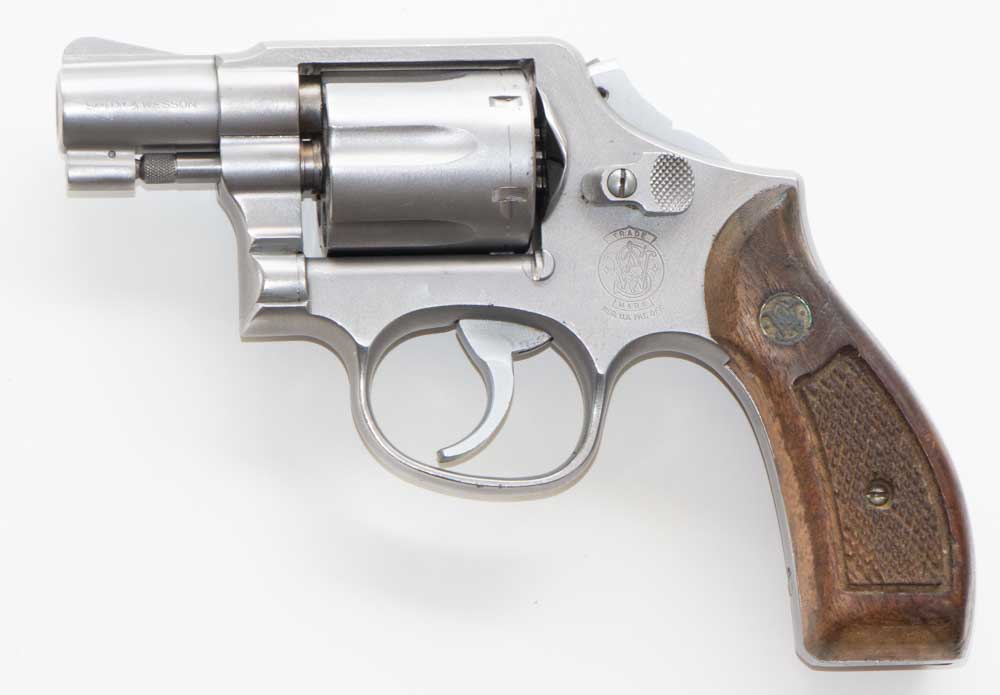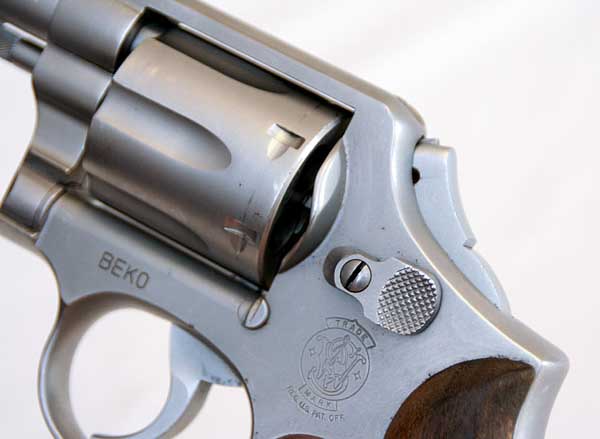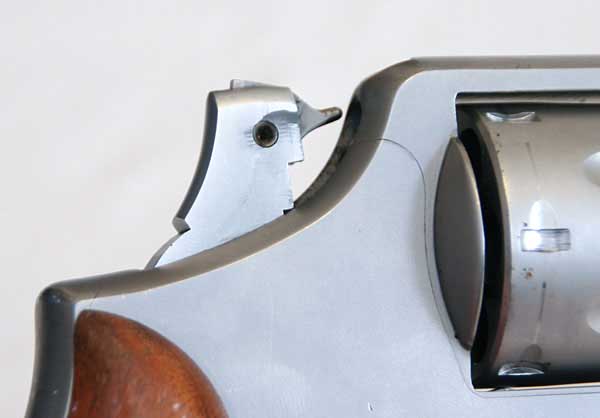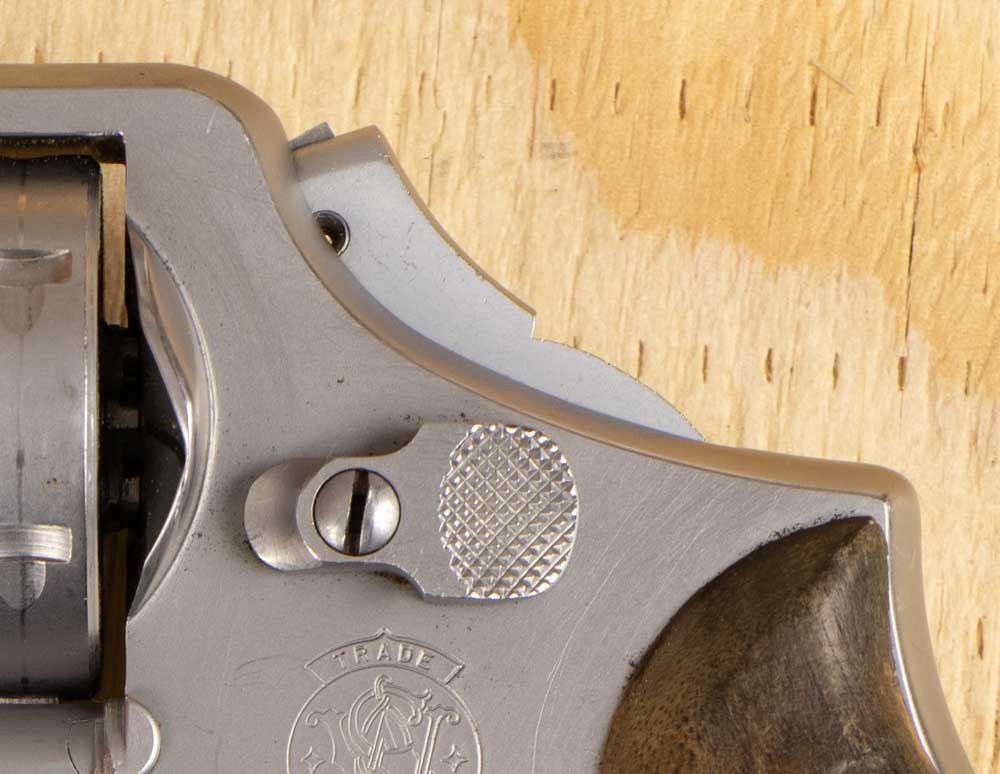Time was when it was popular to cut the spur off a revolver’s hammer to keep it from snagging in your pocket or coat linings when you made a fast draw. Combat shooting authority Paul Weston, who favored this type of modification, aptly described the standard hammer as fishhook shaped.
These days, the spurless, “de-horned” or “bobbed” hammer is undergoing a renewed surge of popularity, and for more sophisticated reasons. The name has also changed: in expert circles, they’re called “speed hammers” now.

The rationale behind grinding off the thumb-cocking spur extends beyond pocket guns: you’re seeing it often now on huge, fifty- and sixty-ounce competition PPC revolvers. The reason is that, if you can be content to shoot double action only (or mostly), you get quicker lock time and actually more positive ignition. That’s right, more positive ignition. For many years, it was assumed that because this procedure lightened the hammer, it could mean that the primer wouldn’t be hit hard enough to go off. This was indeed the case with some guns like the Colt Python, though most standard S&W’s could absorb the alteration with equanimity. The thing of it is, speed as well as weight of hammer fall determine the potency of the firing pin’s impact on the primer, and—if the job has been done by someone who understands the weapon—the removal of weight is often more than made up for by the snappier momentum of the lighter hammer, which resists the mainspring less and therefore gets thrown forward harder.
Jerry Moran of Moran Custom in Clio, Michigan specializes in custom Pythons, and he swears that his specially built speed hammer hits Magnum primers more decisively than any standard hammer. Yet this won’t be the case if you just grind the spur off the hammer that came on the gun. The Python is more sensitive to this operation than most. Contrary to a sometimes-voiced belief, you can generally chop the spur off a Cobra or Detective Special as fearlessly as off a Smith; the myth that it will compromise the little Colt’s reliability dates back to a period many years ago when a large quantity of D-frame Colts allegedly left the factory with too-weak mainsprings. There are now at least two American-made revolvers that come from the factory with optionally-bobbed hammers: the Ruger double actions, and the Security Industries PPM .357. Let’s look at the Ruger, which was the first to offer this worthwhile option. The hammer was designed for Bill Ruger by Hugh Wallace, the master revolversmith at Ruger’s Newport, NH facility where the DA guns are produced. While Hugh’s original intention was to make a sleek, snag-free quick draw gun (in which he admirably succeeded), the bobbed version also cures a serious problem with the double action Ruger, its heavy, clunky hammer fall. You can work a surprisingly good double-action pull out of a Security or Speed-Six, and excellent accuracy; I won a 6″ Security-Six in a combat match in ’73, and shot it successfully in competition for a year, but never really adjusted to that “clank” when the hammer dropped. The standard Ruger hammer is beefier than it needs to be; the bobbed one is still plenty heavy, but nowhere near as likely to knock you off target when it comes down. Sleekly designed to flow with the shape of the frame, it makes for a handsome revolver as well as a more accurate and manageable one. The tip of the hammer is sharply checkered, so that you can thumb-cock it if you start the hammer back with a little pressure on the trigger (more on this technique later). I’ve now got this hammer on all my DA Rugers, even the 6″.

The other factory-option bob is on the Security Industries snubby, and it’s the best I’ve seen yet for carrying, factory or custom. Instead of being ground off completely flat as a gunsmith will do to an S&W, there’s a little nubbin left that’s too small to snag on anything, but has three definite advantages: (1) With its three deep serrations, it’s extremely easy to get hold of to cock for single action shooting, (2) it’s easier to let the hammer down for the same reason, and (3) the gun will, by virtue of that stub, stay secure in any strap-type holster.
I think the last is the most important because so many of us who carry guns on a daily basis use thumb-break or other holsters that strap the gun in. Trouble is that in the vast majority of these holsters, the spur is the part of the hammer that secures against the safety strap. My 234/ ” Ruger Speed Six .357 stainless will slide readily out from under almost any thumb break strap, without even unsnapping it; if I fell on my back (with right hand carry) it would probably come out by itself. When I carry this piece, it’s in a waistband holster secured by the pressure of my belt, or in a scabbard that’s either friction-tight or spring-tension designed. A very well-fitted duty holster like the Hume Jordan style will hold a bobbed gun quite firmly, but such rigs are the exception, and it’s something to think about if you follow the advice of one recent police writer who suggested that all cops carry spurless revolvers in thumb-break holsters.
We were talking before about cocking the de-horned hammer. It does take a little practice. The first time I did it in a match, I was using a bobbed Detective Special built by the late, great George Hyde for Bill Allard of NYCPD. I found that, even under pressure, it was no trick to start the trigger back and then thumb the hammer back once enough of it had been exposed to get a purchase on. My thumb did, however, get somewhat abraded, and this remains likely with any bobbed Colt or Smith that has the firing pin mounted on the hammer. The flat-faced Ruger and Security hammers are much easier to cock in this manner.

The trouble comes when you’ve cocked the gun, didn’t have to shoot after all, and now must let that hammer down. You suddenly realize that there’s nothing left to let it down by. If you’re experienced in the technique and familiar with the gun, and if your hands are dry, and if you’re not nervous or full of adrenalin after a close call or a tightly-timed match (and if this isn’t the case, what the hell did you cock the gun for?), you can probably let the hammer down without an accidental discharge. I am personally very familiar with bobbed hammers, but I dread having to uncock one, which is why every gun I own that is so constructed or modified is used double action only.
If your S&W or Python is customized for double-action shooting, you’d be a fool not to bob the hammer. In addition to the quick locktime, you reduce the possibility of anyone pulling the hammer back to full cock, a position from which you can no longer release it by simply pulling the trigger. The gun will then be frozen, and won’t work until you take the side plate off and square things away. When you go DA only, be sure you not only remove the hammer spur but also the full-cock notch on the hammer.
On some guns, like the Dan Wesson series, you can’t cock the hammer once the trigger stop has been set for double action only. I know a few people who bob the DW’s hammer anyway, just for the slightly better momentum. The only thing is that, because of the design, it makes for an ugly conversion. I have four Dan Wessons in my present battery, from stock to Cirillo custom, and while all are set for double action only, all still have their hammer spurs intact.
I like dehorned hammers, not only ’cause they’re snag-free and streamlined, but because they do offer definite advantages when done by a custom gunsmith. The aforementioned Moran is convinced that he can take a pound to half a pound off your Colt’s DA trigger weight by going to the speed hammer. I don’t doubt it.
In addition to the ones I mentioned above, two other bobbed guns have recently found a place in my battery, both K-frame S&W .38s by Ron Power (Box 1604, Independence, MO 64055). One is a 6″ heavy barrel “full-house PPC gun” that I’ll be using in NRA open-class competition, DA only; another is a Combat Masterpiece that he built for me to shoot in 4″ “service revolver” side-matches. Both formats are DA only, and I love ’em. By the end of the year, I may have a couple more bobbed wheelguns: I’ve got a Detective Special slated for a little plastic surgery, and I’m thinking about sending my Moran 6″ Python back for one of those speed hammers. As sweet as the action is by itself, and as much as I like the gun for the Distinguished (“leg”) matches in PPC shooting where the gun has to be SA-DA, I don’t like the way that beavertail hammer hits the web of my hand when I’ve got a high-ride two hand hold.
Auto pistols, too, can be bobbed, though the operation is seen much less frequently. It’s a cheap, easy, and logical answer for the guy who gets “hammer bite” in the web of his hand with a GM 45 even with the long safety. Just be sure to grind off only enough to alleviate the pinching problem, so you’ll still have enough left to hold onto when you lower the hammer. I’ve seen Browning Hi-Powers, Colt Commanders, S&W model 39s, and other “burr-hammer” autos on which the rear of the circular spur has been cut away, leaving a little half-moon of metal protruding from the rear of the hammer. On the older Browning and the Colt, this still seems to leave enough to give you a good hold when you’re easing the hammer down. On the S&W, many ‘smiths are amputating the hammer spur entirely, on the theory that since you drop the hammer on the safety bar via the thumb safety anyway, the hammer spur is extraneous. Austin Behlert is building a Mini-Combat conversion of the model 39 for me to those specs, and he’s a firm believer that that’s the way to do it. I don’t want to argue with somebody who knows a lot more about modifying the Smith Parabellum than me, but I do get just a trifle queasy about trusting the hammer block …still, Austin might get queasy about me
carrying cocked and locked 1911’s in my waistband. I doubt if anybody’s going to have an “accidental” with either of our guns.
The speed hammer? For any gun, it’s got a lot going for it, but you’ve got to have it either factory-fitted, or integrated with your gun by somebody who knows what he’s doing. You may not want the option for as many of your guns as I do, but that Airweight Chief or bull-barrel PPC gun of yours may just give you a little better performance if you have the alteration made. If you’re dehorning a police uniform gun, just make sure that (a) the gun can’t be brought to full cock afterward and that (b) your holster doesn’t require a hammer spur to keep the gun secured.
When people first started chopping off hammer spurs, they didn’t realize the subtle advantages of the operation, and probably didn’t take advantage of them. The early “gun butchers” who lopped off the spurs usually also cut away the front of the trigger guard (impairing safety), and removed the front sight (reducing defensive capability to something a little beyond the range you’ll find inside a telephone booth). From those days, the bobbed hammer is the only modification that has not only survived but grown in popularity.
Considering some of the weird things people do to guns, one out of three may not be that bad!

One reply on “Bobbed Hammers and Concealment Holsters”
I enjoy reading Ayoob’s material. I’m happy to see him writing here now as well!